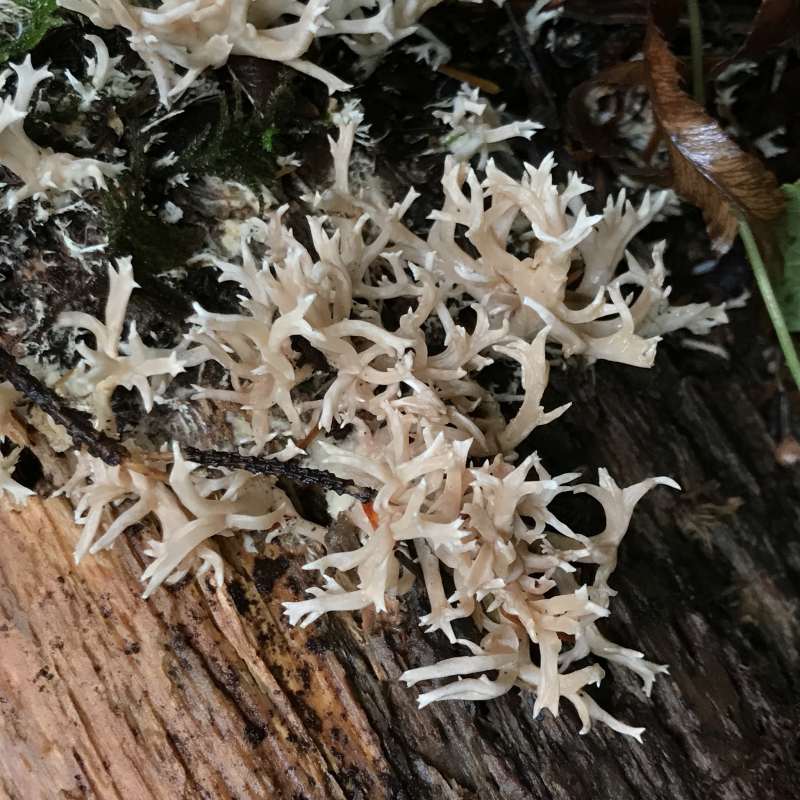
© Christian Schwarz
Danny’s DNA Discoveries – Lentaria of the PNW
by Danny Miller
Click here for my Pictorial Key to Lentaria.
|
|
Danny’s DNA Discoveries – Lentaria of the PNW
Click here for my Pictorial Key to Lentaria. |
|
Introduction
The Gomphales is the order of macro-fungi in the Basidiomycota that is the biggest taxonomic mess right now. Our species of Lentaria may need a new name. The type species and other tropical species are in one clade, and the temperate species like ours are in a second clade. So far only ITS has been examined, but they don't seem to belong together and maybe not even in the same family. A multi-gene study is needed. For now, I follow Zhang and call our species Lentaria B in my tree. The true Lentaria, Lentaria A (with smooth spores), are near or possibly even inside the older Ramaria-like genus Phaeoclavulina (with spiny spores). As for our Lentaria, Lentaria B (with smooth spores), they may be in a clade with four smaller clades of Ramaria subgenus Lentoramaria (with warty spores that are duller and rounder than the sharper spines of Phaeoclavulina) and Clavariadelphus, which are clubs, not corals. If this is true, then either all those species may need to be placed in the oldest genus, Clavariadelphus, or Ramaria subgenus Lentoramaria may need to be split into 4 cryptic genera. Neither is an ideal solution. A multi-gene study is needed. Lentaria are conifer wood-inhabiting, pale corals with smooth spores, a lot like Clavulina, but those grow on the ground. Also unlike Clavulina, Lentaria are sometimes bitter, not as highly branched and with white tips that look less "busy". They are even more likely to be mistaken for some wood-inhabiting pale Ramaria, but those are usually taller and have warty or spiny spores, unlike the short fruitbodies and smooth spores of Lentaria. Hydnocristella - a toothed crust genus with a fluffy white subiculum. Kavinia - another toothed crust with a fluffy white subiculum but with green teeth instead of white teeth. It may be paraphyletic inside Lentaria B and may need to be moved into whatever genus our Lentaria end up being called, or perhaps Lentaria B will be split up even further. Again, a multi-gene study is needed to find out. Ramaricium - more crusts, more details later. abundant common uncommon rare - colour codes match my Pictorial Key and are my opinions and probably reflect my bias of living in W WA. Rare species may be locally common in certain places at certain times. |
|
Summary of Interesting Results
Here are some of the newest, most interesting results of the study:
|
|
Hydnocristella Hydnocristella PNW01 - white teeth growing out of a fluffy white subiculum on wood. Our species appears distinct from Hydnocristella himantia NC, the name we have been using for it. We have one sequence from OR. Hydnocristella PNW01 © Mike Potts (immature and without teeth) and Kim Traverse (mature)
Kavinia Kavinia cf alboviridis OH - green teeth growing out of a fluffy white subiculum on wood. This genus may be paraphyletic inside Lentaria B. We have UK sequences purporting to be this, but no local sequences nor type area sequences (although one purported type area sequence was actually a Hydnocristella). We need collections from both coasts. unsequenced Kavinia alboviridis © Noah Siegel and the USDA Forest Service
Ramaricium More crusts. More details later.
Lentaria B Lentaria pinicola ID var. robusta ID - the type was sequenced and 4 WA and OR sequences match it fairly well, differing mostly in a few ambiguous locations. One WA sequence is 3 bp and 3 indels different, so it could possibly be different. It does seem to have more robust branches than the type variety It has been found fruiting on a Doug fir cone - the type of conifer substrate doesn't seem to matter. See the introduction for how to differentiate it from the very similar Clavulina and Ramaria. Lentaria pinicola ID - A sister species has been sequenced in CA twice and once in WA, those three sequences share the same ITS1 but differ by 3 bp from each other in ITS2. This is probably Lentaria pinicola var. pinicola ID, but if it isn't, we'll have to figure out what is. One sequence from WA is somewhat different by 1% or so, and is so far unique. Lentaria cf epichnoa EU - with narrower spores (2.5-4u compared to 4.5-5.5u), reported from BC, but we have no sequences from either the EU nor locally to verify this. Lentaria albovinacea EU (=Clavicorona divaricata ID?) - We know nothing about this, and even the genus is in dispute. We need the type sequence. Lentaria pinicola var. robusta © NAMA and the Field Museum of Natural History, Lentaria pinicola © Sadie Hickey
'Lentaria' albovinacea EU (Typhulaceae PNW01) - turns out to need a genus near Typhula so it is discussed there. |